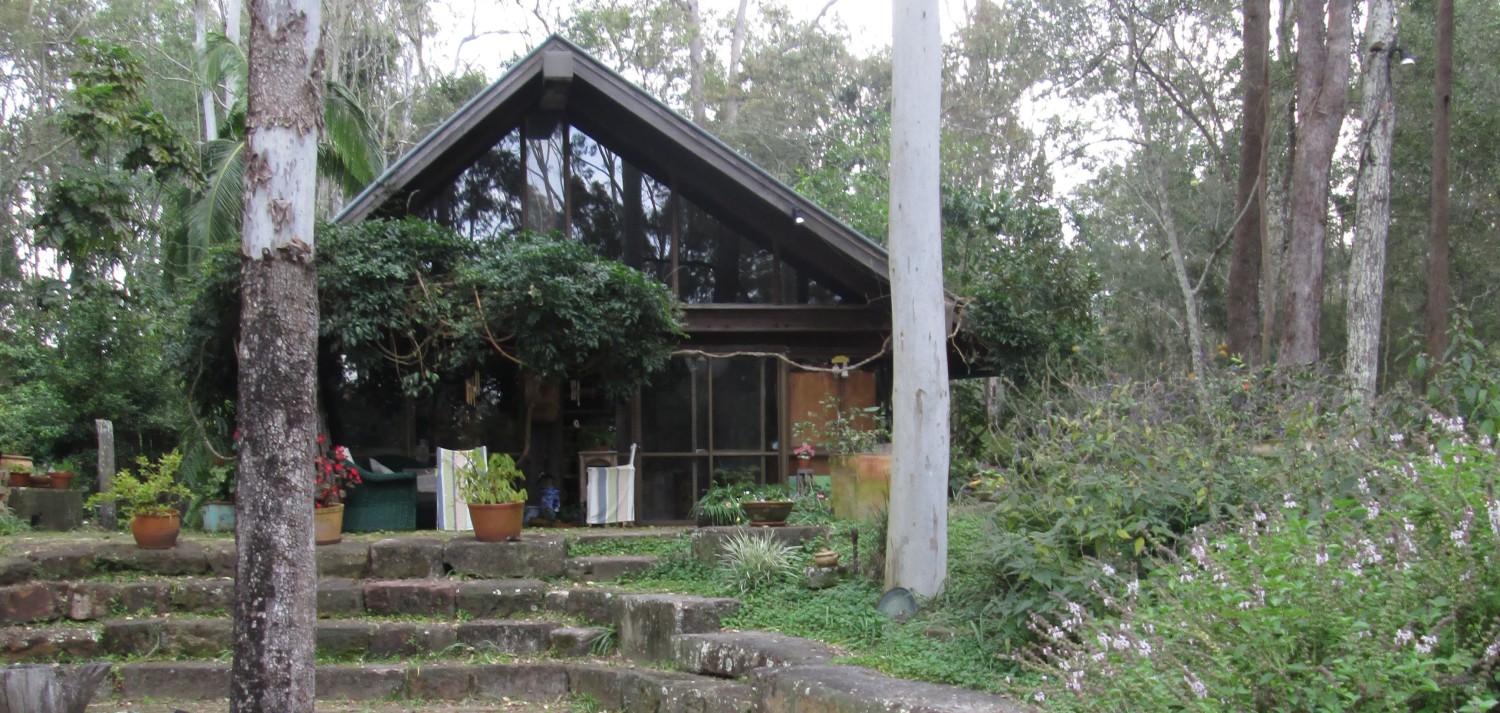___________________________________________________________________________
Note: I would like to share with you through these few words, photographs and hyperlinked websites, a 3 Dimensional experience as though you were actually there with us. Click on any photograph and it should enlarge to a different size ….. at least half screen or size full screen. It will be clearer in detail than the photo on the post. It will be as if you were really there looking at the actual scene. You are an armchair traveller with us.
____________________________________________________________________________
In 2016, the house is looking well finished in the setting of the bush. Birds flit around the glass outside with strident bushland calls. Occasional wild ducks shelter beside the water-filled ponds which drain thunderstorm water away from the house. In summer if water remains, blue waterlilies multiply from last years seed left in the muddy bottom when the ponds have dried up.
______________________________________________________________________________
The Australian Wood Duck
…. pays us an occasional visit in groups of two or three ducks. They waddle across our land generally amongst the taller grass looking for insects and things to eat. They do not normally swim in the water of our ponds as black ducks often do.
See the website: Images for Australian wood duck.
 These big posts have been in the ground for 30 years since 1984. It is used to form the edges of a Garden Room outside our bedroom. The top of the post has rotted away leaving a 150 mm depression in the top of the post. A pair of birds have made their nest in the top of the post. The eggs have hatched out to give little babies which are fed by the parents flying back and forth. See the photo below.
These big posts have been in the ground for 30 years since 1984. It is used to form the edges of a Garden Room outside our bedroom. The top of the post has rotted away leaving a 150 mm depression in the top of the post. A pair of birds have made their nest in the top of the post. The eggs have hatched out to give little babies which are fed by the parents flying back and forth. See the photo below.
 The Blue Faced Honey Eater is a brightly coloured, bold and loud bird, found in the bush as well as in town. It grows to 26cm. The adults have a distinctive blue skin patch around their eyes. It has a bright olive back with a black head and throat. Its underbody is white. Young Blue Faced Honey Eaters have a green facial patch.
The Blue Faced Honey Eater is a brightly coloured, bold and loud bird, found in the bush as well as in town. It grows to 26cm. The adults have a distinctive blue skin patch around their eyes. It has a bright olive back with a black head and throat. Its underbody is white. Young Blue Faced Honey Eaters have a green facial patch.
Very occasionally, koala bears pass through our land on the way to other places. They eat the leaves of a certain kind of eucalyptus tree. There are hundreds of kinds of eucalyptus trees in Australia but only a few species that they feed on. Read more on this website.
There are many wallabies on our land …. even present during the day. You could be having lunch outside and a wallaby jumps along a boundary fence nearby. You might come home at night and a wallaby jumps down the driveway ahead then jumps off to the side among the trees. One morning about a year ago, Harriet came quietly to me at about 7.30 am. me in the kitchen and silently motioned me to come quietly up to our bedroom. We have glass all around our house and our bedroom looks out over a pond with water and water lilies. See the photo below. A sloped bank rises up about 2.00 metres high to flow into the slight slope of our land. On top of the bank was a really amazing scene. A mother wallaby was bent down feeding on the grass. She had a full pouch with a little joey with his head out, looking at the world. When she finished feeding, she jumped down the land with about five other wallabies. It was just beautiful to be so close to a wild animal yet would not have seen us as the glass wall would show reflections of the surrounding bush.
The pond outside our bedroom. We have seen black ducks swimming in this pond amongst the waterlilies.
Mother possum with a little baby possum
One morning a few years ago I was in my office. My wife had gone to work and I heard a little sound out in the front arbour area. I went out and here was the little baby possum on the brick paving at the front door. I realised he must have fallen down from his mother who slept up in the outside /\ of the top projecting ridge beam. I picked him up and placed him on one of the arbour vines with the hope he could back up to his mother. I went back to my office and soon I heard a bigger sound. I went back out and here was the mother possum down on the paving getting the baby onto her back. She climbs up one of the arbour vines to reach a 50 mm wide timber edge on the front /\ window. She walks along this ledge for 2.00 metres then turns around and starts going the other way. The bush trees are reflected in the glass so I run in and get my camera and get this photo.
Red-tailed black cockatoo
…. The red-tailed black cockatoo also known as Banksian or Banks black cockatoo, is a large black cockatoo native to Australia. Adult males have a characteristic pair of bright red panels on the tail that gives the species its name.
___________________________________________________________________________________________________
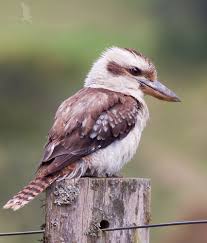
Every morning we hear the kookaburras greeting the coming day about an hour before sunrise. Their funny laughing call reverberates through our bush. Recently, a friend of mine was telling me about when he first came to live in Australia permanently from New Zealand. He heard this funny laughing sound in the morning and he wondered who on earth was laughing at him so early in the morning. He soon learnt that it was kookaburras.
______________________________________________________________________________
Rosella parrot
…. From Wikipedia, the free encyclopedia: Ranging in size from 26–37 cm
(10–14.5 in), rosellas are medium-sized parrots with long tails. The feathers on their backs show an obvious scalloping appearance with colouring that differs between the species. All species have distinctive cheek patches. Sexual dimorphism is absent or slight – males and females generally have similar plumage, apart from the western rosella.
The juveniles of the blue-cheeked species, and western rosella, all have a distinctive green-based plumage, while immature plumage of the white-cheeked species is merely a duller version of the adults ….
See images of Rosella parrots on this website
______________________________________________________________________________
The Australian king parrot
…. This morning in October 2015, this beautiful parrot pays us a visit by sitting on a branch over one of our ponds. The bright red and the brilliant green feathers stand out amidst the grey-green leaf foliage. This parrot is normally found in humid and heavily forested upland regions of the eastern portion of the Australian continent, including eucalyptus wooded areas in and directly adjacent to subtropical and temperate rainforest. They feed on fruits and seeds gathered from trees or on the ground.
See images of King parrots on this website
______________________________________________________________________________
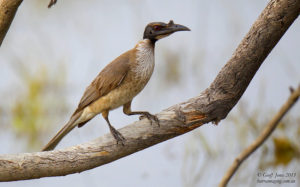
The Noisy Friarbird prefers dry forests and eucalypt woodlands, as well as coastal scrub, heathlands and wetlands and wet forests, and is found in most climate zones, extending into arid areas along rivers. It is frequently seen on our land among the gum trees. In early September 2016 (the start of Spring in Australia), a pair of noisy friarbirds made a nest up in the native wisteria vine growing over the arbour. See The Outside Amphitheatre Garden Room for details on the native wisteria vine. They have eggs hatched out and parent birds kept flying back and forth feeding their chicks. It was wonderful in hearing the cry of the chicks with each feeding.
In the last few weeks, another pair of Noisy Friarbirds have made a nest inside a shallow basket hanging outside a kitchen window. The basket hanging outside about 1.50 metres away from the kitchen sink. Through the glass, you would see the birds flying back and forth with web-building material. As of the 17th of September, there are suddenly have two eggs in the nest. See the two photographs below. It is how to have close intimacy with the birds on our land.
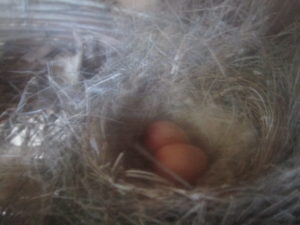
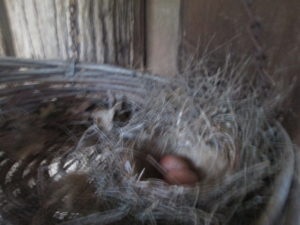
________________________________________________________________________________________

_____________________________________________________________________________________________________
The magpie-lark (Grallina cyanoleuca), also known as the peewee, peewit or mudlark, is a passerine bird native to Australia, Timor and southern New Guinea. The male and female both have black and white plumage, though with different patterns. John Latham described the species in 1801. Long thought to be a member of the mud nest builder family Corcoracidae, it has been reclassified in the family Monarchidae (the monarch flycatchers). Two subspecies are recognized.
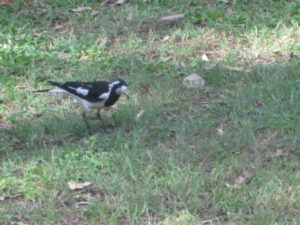
______________________________________________________________________________________
…. Pacific Black Duck ….
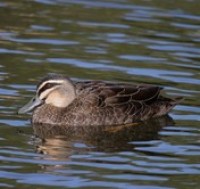
From this website:
The Pacific Black Duck is mostly mid-brown in colour, with each feather edged buff. The head pattern is characteristic, with a dark brown line through the eye, bordered with cream above and below and a dark brown crown. The upper wing colour is the same as the back, with a bright glossy green patch in the secondary flight feathers. The white underwing is conspicuous in flight. Young Pacific Black Ducks are similar to the adults in plumage.
Where does it live?
The Pacific Black Duck is found in all but the most arid regions of Australia. Outside Australia, its range extends throughout the Pacific region.
The Pacific Black Duck is one of the most versatile Australian ducks. It frequents all types of water, from isolated forest pools to tidal mudflats. Pacific Black Ducks are usually seen in pairs or small flocks and readily mix with other ducks. In the wild, birds are often very wary of humans and seldom allow close approach. Birds in urban ponds become quite tame, however.
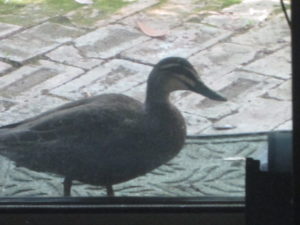
… In November 2017, I was home by myself as my wife had gone out. I heard a little sound outside on the north side of the house where our ponds are located.
I went to have a look and here was a black duck pecking at the glass. It was being territorial and pecking at its own reflection in the glass window. we have a similar situation with another small bird species. It is very annoying at times as you have to go and shoo the bird away.
The black ducks, normally swim and forage for food in one of three large ponds.
A pair of black ducks have taken to crossing our front lawn and wandering through our garden. They are becoming quite tame. We have a big aviary on our land with many birds …. but we live in the aviary = the house but the birds are outside.
___________________________________________________________________________________
Common bronzewing Dove
We have a dove that has made its shallow nest just near our BBQ. You can get near the bird on the nest to nearly one metre away. Even then you need to move a small branch before it flies off the nest to leaves two eggs behind.
From Wikipedia, the free encyclopedia
The common bronzewing (Phaps chalcoptera) is a species of medium-sized, heavily built pigeon.[2] Native to Australia and one of the country’s most common pigeons, the common bronzewing is able to live in almost any habitat, with the possible exception of very barren areas and dense rainforests.
Description
Males of the species have pale-yellow to yellow-white foreheads, and pink breasts.[2][4] Both males and females have an easily discernible white line around and proximate to their eyes. Common bronzewings also have patches of red, blue and green on their wings, a feature that is characteristic of all bronzewing pigeons.[2][4] Young birds are usually duller in colour and browner than the mature common bronzewing.
Rarely found far from a source of water, common bronzewings either travel alone or in pairs or in flocks and are usually cautious, making approach by humans or other animals difficult.[2] Common bronzewings are, on average, between 30 and 36 centimetres (12–14 in) in length.[3]


________________________________________________________________________________
Reptiles: Lizards

Australian water dragon
From Wikipedia, the free encyclopedia
Australian water dragons have long powerful limbs and claws for climbing, a long muscular laterally-compressed tail for swimming, and prominent nuchal and vertebral crests.[5] (A nuchal crest is a central row of spikes at the base of the head. These spikes continue down the spine, getting smaller as they reach the base of the tail.)[6]
Including their tails, which comprise about two-thirds of their total length, adult females grow to about 60 cm (2 feet) long, and adult males can grow slightly longer than one metre (39 inches) and weigh about 1 kg. Males show bolder colouration and have larger heads than females.[7][8] Colour is less distinct in juveniles.[9]
______________________________________________________________________________________________
See the next post: The motivation for building our hand-made house design
________________________________________________________________________________
